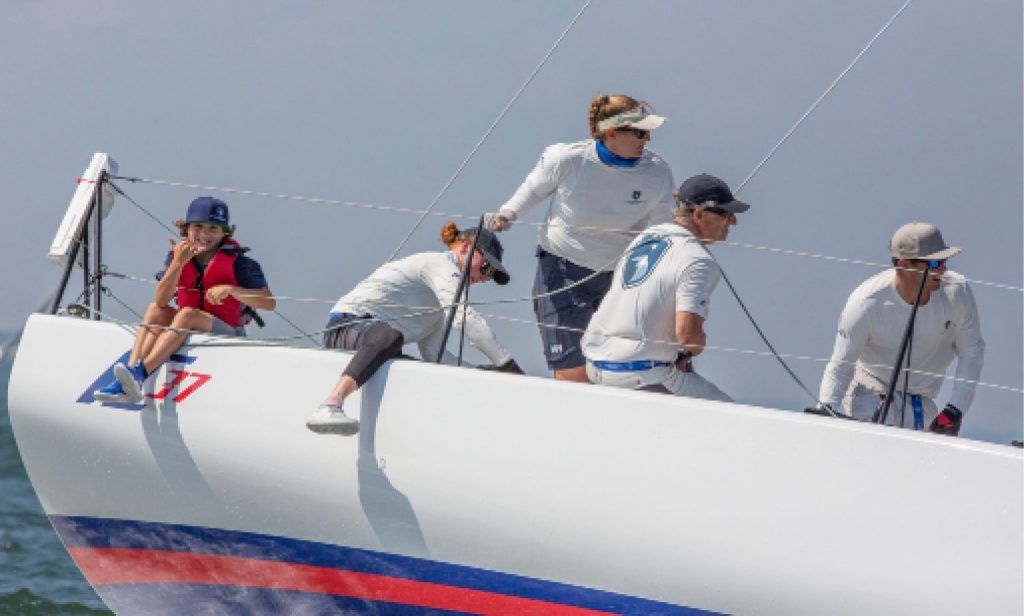By Ben Cesare
I can’t recall a time when the focus on big boat sailing for kids was so top of mind as it is currently. It’s very refreshing in that success so obviously provides exposure to many of the core values of enjoying a life on the water. At WindCheck, our view is pretty narrow geographically, by design. That means we are watching and listening to what’s happening from New Jersey to the Cape. And what we hear is that the values related to seamanship, responsibility, teamwork and enjoyment gained from different kinds of sailing, broader than the world of say, racing singlehanded dinghies, is definitely becoming an imperative to those who help drive our sport in the formative years for kids.

Sail Newport’s Mentoring program was created to inspire legions of lifelong sailors. If this IC37 sailor’s smile is any indication, it’s working! © sailnewport.org
To learn what’s going on at a mainstay of teaching kids about the water in the Northeast, I sat with Sail Newport Executive Director Brad Read and Race Programs Director Nick Ewenson to talk about their (and Program Director Kim Hapgood, who was attending US Sailing’s Leadership Forum in San Diego) desire and methods to get kids into big boat sailing.
Right out of the gate, the tagline came from Nick. “We are trying to broaden the pathways for kids who want to learn the basics in order to enjoy a lifelong interest in ‘big boat sailing,’ whether that be cruising or racing.”
OK, next question…how? “Exposure. Exposure to everything from 40-footers to small powerboats, J/22s to RS21s and C&C 30s. Exposure to the people associated with the program is a huge draw as well.”
But…who? “Kids who want to sign up for evening sessions that happen twice a week.”
Ahhhh…so it’s not a daily program. At this point I started to see something different. I had expected a standard program where kids checked ‘Big Boats’ on the application form for the summer. “No,” Nick explained. “Kids might be working, playing another sport, or sailing 420s during the day. This is designed to make it a commitment but not an unachievable one. Plus, our programs are broken into one-month increments; two evenings a week. This makes it hard on staff, but flexibility is key in today’s world.”
But who’s doing the teaching? “Mentors. We recruit mentors. Some of them come to us, and some raise their hands to want to help kids. We do some vetting of course, but here at Sail Newport we are fortunate to have such knowledgeable and generous mentors. These folks are sold on what we’re trying to build, and eager to share their time…and often their boats, too. Mentors are key to our success on this program. So we create the platform and the goals and basically recruit or take advantage of the opportunities as they arise. One week it might be a volunteer who wants to take the kids on a cruise around the bay to practice anchoring, and the next it might be an evening PHRF race. It’s primarily about exposure to ignite the desire to learn more.”
Brad now checked in. “Who is going to teach these kids how to anchor, how to spring a boat properly at a dock, how to reef a shorthanded big boat, or how to use a winch properly? If you go straight from Optis to 420s to college sailing, it is quite possible that you will learn none of these things. Thus the odds of you wanting to go cruising when you’re in your twenties and older are much, much lower. The odds of wanting to go race Shields with some buddies on a Thursday eve are probably lower, too. I think the lifetime sailor needs to have these skills, and we need to provide a path that fits to get them.”
Bravo! It is always fun to witness people putting creative solutions to work. To learn more, visit sailnewport.org. And if you want to help, drop Kim, Nick or Brad a line and see if they can squeeze you in! ■




